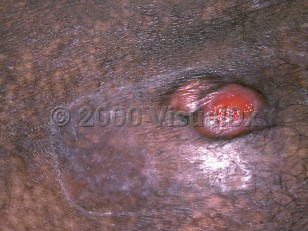Lymphoma in Adult
Alerts and Notices
Important News & Links
Synopsis

Non-Hodgkin lymphoma (NHL) of B-cell origin accounts for 4%-5% of new cancers in the United States, with a lifetime risk of 2%; the incidence has doubled over the last 2 decades in Western developed countries.
Geographic factors affect the incidence of certain types of NHL (eg, an increased incidence of Burkitt lymphoma in Africa and human T-cell lymphotropic virus type 1 [HTLV-1]-associated lymphoma / leukemia in Japan and the Caribbean). Incidence rates are higher for white males and have a median age of presentation of 50 (although this is often lower in HIV-infected individuals).
Secondary B-cell lymphomas often presenting in the skin include the following: intravascular large B-cell lymphoma (malignant angioendotheliomatosis or angiotrophic lymphoma), which involves the skin and central nervous system (CNS); and lymphomatoid granulomatosis, an angiocentric Epstein-Barr virus (EBV)-positive lymphoma always involving the lung and often the skin.
Secondary T- and NK-cell lymphomas with cutaneous manifestations include the following: subcutaneous panniculitis-like T-cell lymphoma (< 1% of NHL), HTLV-1-associated adult T-cell leukemia-lymphoma, blastic NK-cell and extra-nodal NK-cell lymphomas. CD30+ lymphomas, which can be of B- or T-cell origin, have primary and secondary cutaneous variants, as well as large cell and anaplastic forms.
Hodgkin disease may rarely occur with cutaneous lesions, usually as a direct extension of nodal disease.
Generalized pruritus may be present, particularly in Hodgkin disease and adult T-cell leukemia-lymphoma. Otherwise, most cutaneous lesions are asymptomatic.
Systemic symptoms include fatigue, fevers, night sweats, and weight loss. Symptoms may also occur due to mass effect or specific organ involvement (neurologic symptoms, dyspnea, cough, and chest, abdominal, or bone pain). Signs include lymphadenopathy, fever, tachycardia, respiratory distress, pallor, and purpura. Some lymphomas have renal manifestations (monoclonal gammopathy of renal significance [MGRS]). These include B-cell lymphoma, lymphoplasmacytic lymphoma, and chronic lymphocytic leukemia.
In the HIV-infected population, lymphocytic malignancies of both B- and T-cell origin may develop, particularly with CD4+ counts < 200 cells/mm3. NHL is the second most common neoplasm associated with HIV, most of B-cell lineage. Half of these are associated with chronic Epstein-Barr virus (EBV) infection. The incidence has decreased since antiretroviral therapy availability. HIV-infected patients tend to have a younger age of onset, more advanced disease, and extranodal involvement (CNS, skin, and intestine). The incidence of Hodgkin disease and T-cell lymphomas may be higher in HIV infection but is less frequent than B-cell lymphoma.
Other immunodeficiency states, which predispose to NHL, include congenital immunodeficiencies, iatrogenically immunosuppressed transplant recipients, and patients with connective tissue disease.
Some environmental risk factors may contribute to NHL: previous chemotherapy or radiation therapy, chemicals (pesticides, herbicides, solvents, organic chemicals, and wood preservatives), and some occupations (farmers, pesticide users, flour millers, meat workers, painters, mechanics, and those working in the petroleum, rubber, plastic, and synthetics industries). Textured breast implants have been associated with an increased risk for large cell anaplastic lymphoma.
Codes
C85.80 – Other specified types of non-Hodgkin lymphoma, unspecified site
SNOMEDCT:
118600007 – Malignant lymphoma
Look For
Subscription Required
Diagnostic Pearls
Subscription Required
Differential Diagnosis & Pitfalls

Subscription Required
Best Tests
Subscription Required
Management Pearls
Subscription Required
Therapy
Subscription Required
Drug Reaction Data
Subscription Required
References
Subscription Required

